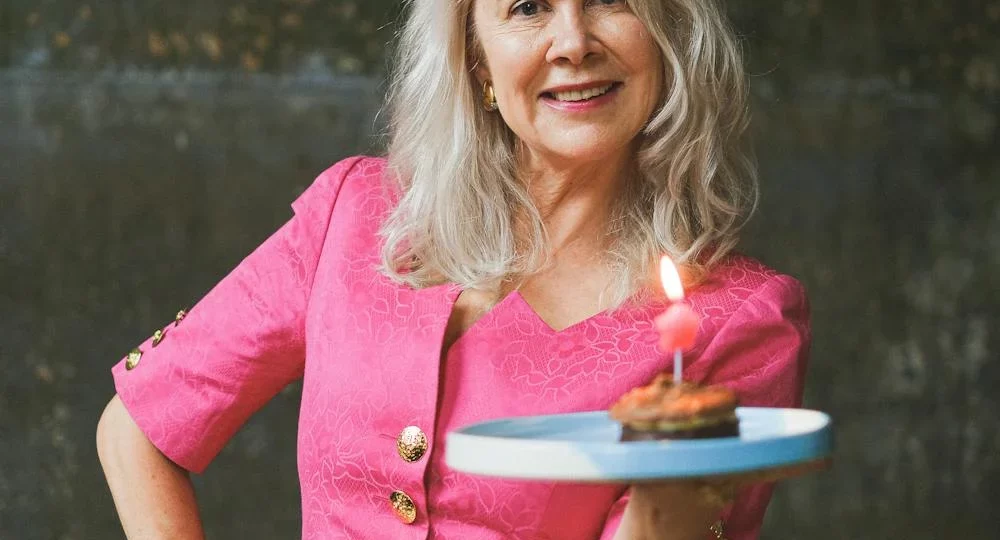
How three women rewrote the rules of reinvention—and an entire industry
The phone call that changed Caroline Baudino’s life came at 2 AM. Her mother’s voice, frantic with news of her father’s Alzheimer’s diagnosis and mounting family crises, would have sent most people into retreat. Instead, the 53-year-old Los Angeles content creator looked in her hallway mirror and saw a stranger. “Where is the independent badass that would never depend on anyone?” she asked her reflection.
That moment of reckoning launched Baudino from suburban mom to fashion influencer with 1.4 million followers—part of a quiet revolution reshaping an industry that has long worshipped youth above all else.
Across the country, Nancy Volpe Beringer was having her own moment of truth. At 58, the successful professional made what friends called a “monumentally risky” decision: she quit her secure career to pursue fashion design at Drexel University. By 61, she had not only graduated with record-breaking honors but was dressing Grammy nominees and pioneering adaptive luxury fashion for disabled clients.
And back in 2007 screenwriter Marla Wynne had her own crisis and self-reckoning. Her breakdown or face the music moment came when Hollywood’s 2007 writers’ strike dried up her income. At 50-something, with no fashion experience beyond admiring Parisian street style, she bought a sewing machine and began sketching clothes for “real women who were never going to grace the catwalks.” Today, her designs sell across four countries on major television shopping networks.
The New Rules of Reinvention
What connects these three women isn’t just timing—it’s their rejection of fashion’s fundamental assumptions about age, relevance, and who gets to participate in style conversations. They represent a seismic shift in an industry built on exclusion, creating space not just for themselves but for entire demographics the fashion world has historically ignored.
Beringer’s story is perhaps the most dramatic departure from fashion’s traditional trajectory. While most designers emerge from prestigious programs in their twenties, she was already established in another field when she decided to chase a childhood dream. “The success and security I had built professionally over several decades didn’t fully scratch the creative itch I felt as a young girl who loved to sew,” she explains.
Her gamble paid off spectacularly. Beyond the viral Grammy red carpet moment that earned New York Times coverage, Beringer has built something revolutionary: The Vault by Volpe Beringer, the world’s first luxury accessible resale platform. Her runway shows feature the first non-binary model, transgender model, wheelchair user, and model with a prosthetic leg many audiences had ever seen.
“No matter what your ability or disability, you have the same right to use fashion to express your individuality,” Beringer says, embodying what she calls “sustain-our-ability”—a play on words that captures her dual focus on environmental sustainability and inclusive design.
The Viral Velocity of Midlife
Baudino’s trajectory illustrates how digital platforms have compressed traditional career timelines. Her husband’s suggestion to try TikTok was met with resistance: “I was like, ‘Are you crazy? I’m not dancing on TikTok. I’m 50 years old.'” But when three videos went viral simultaneously in 2024, she gained 70,000 Instagram followers overnight and grew from 38,000 to 500,000 followers in two months.
Her success taps into something larger than personal branding—a cultural hunger for authentic voices that speak to midlife experience. “So many women in midlife don’t know how to get started again, but you are smart and capable,” she tells her audience through her “Being Caroline” platform and “Coming In Hot” podcast.
The numbers tell the story: Baudino’s empire now includes affiliate partnerships, brand collaborations, speaking engagements, and investments in three tech companies. Her merchandise drops sell out, proving that midlife audiences represent serious economic power.
The Mass Market Revolution
Wynne’s path reveals yet another route to fashion influence. With no industry connections or sewing skills, she identified a massive underserved market: women who wanted to look stylish without conforming to youth-oriented trends. Her memory of Parisian women who “seemed to avoid the fashion disasters of un certain age” became the foundation for a line that celebrates strategic coverage and sophisticated styling.
Working through television shopping networks rather than traditional fashion channels, Wynne bypassed industry gatekeepers entirely. Her designs now reach audiences across the United States, Canada, the United Kingdom, and Italy—a reminder that fashion’s future may lie outside its traditional power centers.
The Momentum Continues
What’s remarkable about these three pioneers is their forward momentum. Beringer continues expanding her adaptive fashion platform while advocating for refugees and sustainable practices. Baudino is planning a book and eyeing talk show opportunities with characteristic ambition: “I hope to tell Tony Robbins to move over.” Wynne, now working with her daughter, declares she has “another 20 years on this planet” and is “having a blast growing this business.”
Their collective success suggests that fashion’s midlife moment isn’t a trend—it’s a correction. In an industry that has long celebrated the new and disposable, these women offer something increasingly rare: wisdom, authenticity, and the kind of hard-won perspective that only comes with experience.
As Baudino puts it with characteristic directness: “It’s not over. It’s just getting started.”
The fashion world, it seems, is finally learning the same lesson.
How Three Women Rewrote the Rules of Reinvention—And an Entire Industry
The phone call that changed Caroline Baudino’s life came at 2 a.m. Her mother’s voice, frantic with news of her father’s Alzheimer’s diagnosis and mounting family crises, would have sent most people into retreat. Instead, the 53-year-old Los Angeles content creator looked into her hallway mirror and saw a stranger.
“Where is the independent badass who would never depend on anyone?” she asked her reflection.
That moment of reckoning launched Baudino from suburban mum to fashion influencer with 1.4 million followers—part of a quiet revolution reshaping an industry that has long worshipped youth above all else.
Across the country, Nancy Volpe Beringer was having her own moment of truth. At 58, the successful professional made what friends called a “monumentally risky” decision: she quit her secure career to pursue fashion design at Drexel University. By 61, she had not only graduated with record-breaking honours but was dressing Grammy nominees and pioneering adaptive luxury fashion for disabled clients.
Back in 2007, screenwriter Marla Wynne had her own crisis and reckoning. Her breakdown or face-the-music moment came when Hollywood’s 2007 writers’ strike dried up her income. At 50-something, with no fashion experience beyond admiring Parisian street style, she bought a sewing machine and began sketching clothes for “real women who were never going to grace the catwalks.”
Today, her designs sell in four countries through major television shopping networks.
The New Rules of Reinvention
What connects these three women isn’t just timing—it’s their rejection of fashion’s long-standing assumptions about age, relevance, and who gets to participate in the style conversation. They represent a seismic shift in an industry built on exclusion, creating space not just for themselves but for entire demographics fashion has historically ignored.
Beringer’s story is perhaps the most dramatic departure from fashion’s traditional trajectory. While most designers emerge from prestigious programmes in their twenties, she was already well established in another field when she decided to chase a childhood dream. “The success and security I had built professionally over several decades didn’t fully scratch the creative itch I felt as a young girl who loved to sew,” she explains.
Her gamble paid off spectacularly. Beyond the viral Grammy red carpet moment that earned New York Times coverage, Beringer has built something revolutionary: The Vault by Volpe Beringer, the world’s first luxury accessible resale platform. Her runway shows featured the first non-binary model, transgender model, wheelchair user, and model with a prosthetic leg many audiences had ever seen. “No matter what your ability or disability, you have the same right to use fashion to express your individuality,” Beringer says, embodying what she calls “sustain-our-ability”—a play on words that captures her dual focus on environmental sustainability and inclusive design.
The Viral Velocity of Midlife
Baudino’s trajectory shows how digital platforms have collapsed traditional career timelines. Her husband’s suggestion to try TikTok was met with scepticism. “I was like, ‘Are you crazy? I’m not dancing on TikTok. I’m 50 years old.’”
But in 2024, three of her videos went viral simultaneously. She gained 70,000 Instagram followers overnight and grew from 38,000 to 500,000 followers in two months.
Her success taps into something bigger than personal branding—a cultural hunger for authentic voices that reflect midlife experience. “So many women in midlife don’t know how to get started again, but you are smart and capable,” she tells her audience via her Being Caroline platform and Coming In Hot podcast.
The numbers tell the story. Baudino’s empire now includes affiliate partnerships, brand collaborations, speaking engagements, and investments in three tech companies. Her merchandise drops sell out, proving that midlife audiences represent serious economic power.
The Mass Market Revolution
Wynne’s path reveals yet another route to fashion influence. With no industry connections or sewing skills, she identified a massive, underserved market: women who wanted to look stylish without conforming to youth-driven trends. Her memory of Parisian women who “seemed to avoid the fashion disasters of un certain âge” became the foundation for a line that celebrates strategic coverage and refined styling.
Working through television shopping networks rather than traditional fashion channels, Wynne bypassed industry gatekeepers entirely. Her designs now reach audiences across the United States, Canada, the United Kingdom, and Italy—a reminder that fashion’s future may lie outside its traditional power centres.
The Momentum Continues
What’s remarkable about these three pioneers is their momentum. Beringer continues to expand her adaptive fashion platform while also advocating for refugees and sustainable practices. Baudino is planning a book and eyeing talk show opportunities with characteristic ambition: “I hope to tell Tony Robbins to move over.”
Wynne, now working alongside her daughter, says she has “another 20 years on this planet” and is “having a blast growing this business.”
Their collective success suggests fashion’s midlife moment isn’t a trend—it’s a correction. In an industry long obsessed with the new and disposable, these women offer something increasingly rare: wisdom, authenticity, and the kind of hard-won perspective that only comes with experience.
As Baudino puts it with trademark clarity: “It’s not over. It’s just getting started.”
The fashion world, it seems, is finally learning the same lesson.

